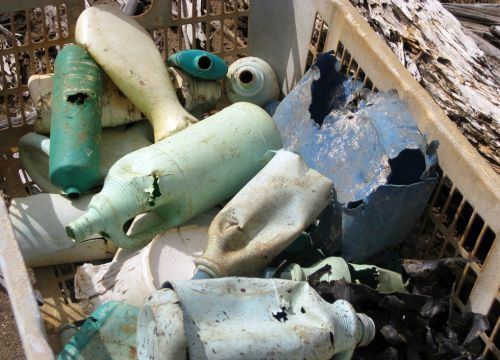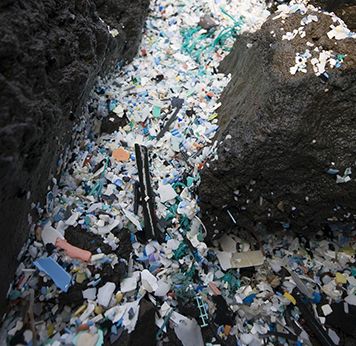How Beach Cleanups Help Keep Microplastics out of the Garbage Patches
JUNE 12, 2015 -- These days plastic seems to be everywhere; unfortunately, that includes many parts of the ocean, from the garbage patches to Arctic sea ice. With this pollution increasingly in the form of tiny plastic bits, picking up a few bottles left on the beach can feel far removed from the massive problem of miniscule plastics floating out at sea. However, these two issues are more closely connected than you may think. But how do we get from a large plastic water bottle, blown out of an overfilled trash can on a beach, to innumerable plastic pieces no bigger than a sesame seed—and known as microplastics—suspended a few inches below the ocean surface thousands of miles from land? The answer starts with the sun and an understanding of how plastic deteriorates in the environment.
The Science of Creating Microplastics
Plastic starts breaking down, or degrading, when exposed to light and high temperatures from the sun. Ultraviolet B radiation (UVB), the same part of the light spectrum that can cause sunburns and skin cancer, starts this process for plastics. This process, known as photo-oxidation, is a chemical reaction that uses oxygen to break the links in the molecular chains that make up plastic. It also happens much faster on land than in the comparatively cool waters of the ocean. For example, a hot day at the beach can heat the sandy surface—and plastic trash sitting on it—up to 104 degrees Fahrenheit. The ocean, on the other hand, gets darker and colder the deeper you go, and the average temperatures at its surface in July can range from 45 degrees Fahrenheit near Adak Island, Alaska, to 89 degrees in Cannon Bay, Florida. Back on that sunny, warm beach, a plastic water bottle starts to show the effects of photo-oxidation. Its surface becomes brittle and tiny cracks start forming. Those larger shards of plastic break apart into smaller and smaller pieces, but they keep roughly the same molecular structure, locked into hydrogen and carbon chains. A brisk wind or child playing on the beach may cause this brittle outer layer of plastic to crumble. The tide washes these now tiny plastics into the ocean. Once in the ocean, the process of degrading slows down for the remains of this plastic bottle. It can sink below the water surface, where less light and heat penetrate and less oxygen is available. In addition, plastics can quickly become covered in a thin film of marine life, which further blocks light from reaching the plastic and breaking it down.
An Incredible Journey
In general, plastic breaks down much, much more slowly in the ocean than on land. That means plastic objects that reach the ocean either directly from a boat (say trash or nets from a fishing vessel) or washed into the sea before much degradation has happened are much less likely to break into smaller pieces that become microplastics. This also applies to plastics that sink below the ocean surface into the water column or seafloor. Instead, plastic that has spent time heating up and breaking down on land is most likely to produce the microplastics eventually accumulating in ocean gyres or garbage patches, a conclusion supported by the research of North Carolina State University professor Anthony Andrady and others. Of course, microplastics in the form of "microbeads" in face wash and other cosmetics or microfibers in fleece clothing also can reach the ocean by slipping through waste water treatment systems. However, regularly patrolling your favorite beach or waterway and cleaning up any plastic or other marine debris can go a long way to keeping millions of tiny microplastics—some so tiny they can only be seen with a microscope—from reaching the garbage patches and other areas of the ocean. The great thing is anyone can do this and you don’t have to wait for the International Coastal Cleanup each September to get started. Find more tips and resources to help you on your way:
- Solutions to marine debris | NOAA Marine Debris Program
- Marine Debris Tracker app for smartphones
- Detecting Microplastics in the Marine Environment | NOAA Marine Debris Program
- Proceedings from two research summits hosted by NOAA and the University of Washington in 2008 and 2010:
 An official website of the United States government.
An official website of the United States government. 

